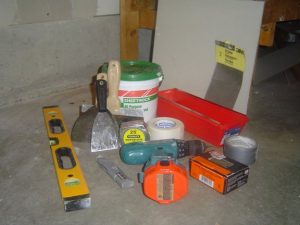Quality Drywall Tools will help to Ensure a Quality Drywall Project
By Mark J. Donovan
|
|
As with any home remodeling task it is important to use the right tools when undertaking a drywall project. When I tackled my first drywall project I used a home-brewed drywall hawk made from a one foot square piece of plywood and a ripped length of 2×4, and a 6″ taping knife, for the entire taping and mudding phase of the project. I also used a homemade drywall lift using a couple of long 2x4s to hold the drywall to the ceiling. The finished results were adequate, but far from professional.
To obtain a professional drywall finish it is important to use the right drywall tools. I view some drywall tools as imperative and others as “nice-to-have”. |
At the top of my list for key drywall tools are a utility knife, drywall screw gun, drywall hand saw, measuring tape, drywall rasp, and a T-square for cutting and hanging drywall. If you prefer to fasten the drywall to the wall studs with nails, then alternative to the screw gun you will need a drywall hammer.
For drywall taping and mudding tools it is imperative to have a 4-6″ drywall joint knife, a 10-12″ drywall taping knife, a mud pan, a pole sander, dust masks and a pair of safety goggles.
The 10-12″ drywall taping knife is necessary for removing excess joint compound on the taped seams after the first application of joint compound, and for applying the finishing coats of joint compound.
| The drywall pole sander, mask and safety goggles are necessary during the sanding phase of the drywall project.
Other “nice-to-have” drywall tools include a drywall lift, a drywall banjo and a router with a special cutting bit. Drywall lifts help to place and attach drywall onto ceilings. A drywall banjo helps in the application of drywall tape and joint compound to the seams, however these tools take a little practice. A router is ideal for cutting out holes for electrical outlets and switches. |
 |
So before you embark on a drywall project make sure you purchase the right drywall tools first.
For information on repairing a large drywall hole, see the “How to Repair a Large Drywall Hole” Ebook from HomeAdditionPlus.com. The “How to Repair a Large Drywall Hole” Ebook provides step-by-step instructions on how to repair your damaged wall so that it looks as good as new.
See HomeAdditionPlus.com’s Drywall Calculator
Related Information
- How to Repair Drywall Nail Pops
- How to Make Large Drywall Hole Repairs with Nothing Behind the Hole
- How to Remove Nails from Walls without Damaging the Drywall
Additional Drywall Installation Resources from Amazon.com
 |
 |
Free Home Addition Price Quotes with No Obligation!
Fill out our 3-5 minute quick and easy form, and receive a free price quote on a house addition from one of our prescreened and licensed home addition contractors. This process is free and there is no obligation to continue once you receive your house addition price estimate.

